With the ever increasing cost of energy, I know everyone would wish to adopt the most efficient way of heating a swimming pool.
This is even critical during the winter season when the weather is extremely cold.
In this article, I am going to teach you how to heat the swimming pool water, besides maintaining the temperature to a suitable threshold.
Most people only focus on ways of heating a swimming pool but none of them try to find out how to conserve this heat.

A kid enjoying swimming in a retractable pool enclosure
So, I will divide this article into two major sections:
- Process of heating swimming pool water
- How to prevent heat loss from the swimming pool
With these, I am certain you’ll extend the swimming season without spending extra money on heating the pool.
Let’s explore each of these aspects:
Process of Heating a Swimming Pool
I know most people will think of solar being the primary source of heat for a swimming pool.
That is, by exposing the entire surface of water to the sun’s radiation they will eventually be heating a swimming pool.
At times, this may not be practical at all. Why do I say so?
Let me ask you some simple questions:
How will you use solar heat during winter?
Obviously, during frosty or raw weather, it will be nearly impossible to depend on sun’s energy as the primary source of heat.
Again, did you know that ultraviolet radiations from the sun not only cause sunburn, but also increase the rate at which swimming pool water chemicals decompose?
This implies, leaving your pool open will alter the PH hence, high cost of treating water.
Don’t get me wrong.
I am not saying heat from the sun is not a cost effective way of heating a swimming pool.
It works effectively but only if you have appropriate measures in place.
Don’t worry I will explain how to harness this natural source of energy in heating a swimming pool.
For now, let’s discuss how to effectively use:
- Gas heaters
- Electric resistance heaters
- Solar heaters
- Heat pumps
Swimming Pool Heat Pumps
Heat pumps have become popular in the recent past due to their efficiency and long term cost saving benefits.
However, the initial cost is quite high and it may range from $1,900 to over $3,700 depending on the size and capacity.
The heaters depend on the surrounding ambient air to heat the swimming pool water, thereby saving on energy cost. Currently, quite a number of heat pumps available are for in ground swimming pools.
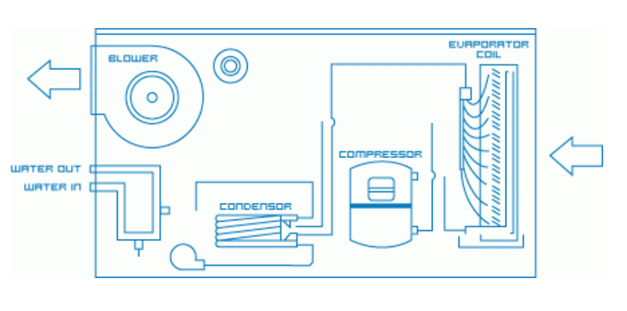
This is a schematic diagram of a heat pump. Image source: The U.S. Department of Energy
The Working Principle of Heat Pumps
When the outside temperature remains within a range of 45° F to 50 °F, the heat pump’s fan will draw warm air from the surrounding environment.
The fan directs the warm air to an evaporator coil, where the liquid refrigerant absorbs this heat and changes it into gaseous state.
This gas will then pass through the compressor, which increases its temperature.
It then goes to the condenser.
Meanwhile, the pump will draw water from the swimming pool, which then passes through the system filter and to pump heater.
In the condenser, hot gas transfers all its heat to the circulating swimming pool water.
As a result, water that flows back to the swimming pool will be warm while the hot gas changes into liquid.
The gas in liquid state will return back to the evaporator.
Normally, this is a continuous process that ensures a swimming pool water temperature remains warm at all times.
As you can see, the working principle of heat pumps is quite simple. Of course, they come in different shapes and designs with varying capacities.
This video shows how a heat pump works.
Now, in case you’re planning to heat your swimming pool using this accessory, there are other factors that will determine its efficiency.
This is why I think you need to know its advantages and disadvantages.
Advantages of Heat Pumps
The modern heat pumps are popular due to the following key advantages:
- Energy efficiency
- Low running costs with monthly cost ranging from only $50 to $150
- Eco-friendly since they emit no pollutants and use renewable energy
- Long life span of about 20 years
Disadvantages of Heat Pumps
However, when you’ve opted to heat pumps, you should be ready to deal with the following challenges:
- High initial cost of installation that $1,900 to over $3,700
- Surrounding temperature must be within 45°F to 50°F, otherwise operating heat pumps will be expensive
- Heating process is slow
Factors to Consider When Buying Heat Pumps
Now, how can you choose a specific pump that meets the specific needs of heating a swimming pool?
I know this is a technical aspect, especially for newbies in this industry. Remember, at any given time, you’ll consider a pump based on the size, efficiency and cost.
So, let’s explore these factors:
Heat Pump Sizing Analysis
I am going to give you a simple way to go about this process just in case you can’t hire someone to do it for you. Alternatively, you can hire trained personnel to help you in the process.
From my experience in this industry, there are a number of things that determine the size of a heat pump. These include:
- Surface area of the swimming pool
- Temperature difference between air and swimming pool
- Wind exposure
- Cool night temperature
- Relative humidity
By considering all these, I am sure you’ll get a heat pump that meets the specific needs of your application. Normally, the heat pumps are rated by horsepower (hp) or Btu.
Efficiency of the heat pumps
We measure the efficiency of heat pumps in terms of coefficient of performance (COP). A pump with high COP is considered to be highly efficient.
In most instances, different manufacturers tend to use a range of test models. The ranges of coefficient of performance vary from 3.0 to 7.0, which can be converted to 300% to 700%.
Swimming Pool Heating Costs and Savings
Obviously, by choosing the right heat pump, you will save a lot of money. This is why I insist on doing a comprehensive analysis before choosing a suitable pump for any application.
Again, you should remember that carrying out the recommended maintenance procedures will optimize the efficiency and operation of the heat pump. This is the reason why you need a professional to help you with the installation and maintenance process.
Electric Resistance Heaters for Swimming Pools
At times, you may have no option but to go for electric resistance heaters. These heaters are quite expensive, especially for people who operate large swimming pools.
Even though you’ll find people using electric resistance heaters, it is a process I don’t advocate for. The truth is that you will incur a lot of energy bills.
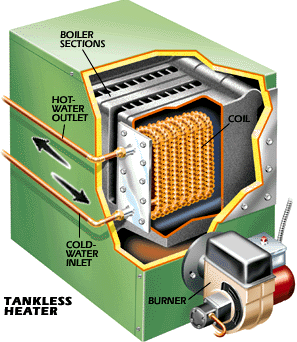
This is an electric swimming pool heater. Image source: Medallion Energy
In case you have to go for this option, then I will only recommend it for portable spars or small therapy pools. Otherwise, you end up giving up on your swimming pool.
Working Principle of Electric Resistance Heater
These pool heaters use electric current to create heat. That is, the current will heat a resistor located in the unit.
With the resistor at a predetermined temperature, water from the swimming pool will wash over resistors. This raises the temperature of water flowing back to the pool.
As a result, the whole swimming pool will be warm.
Advantages of Electric Resistance Heaters
Even though I don’t recommend it for any swimming pools, this system has some advantages. These include:
- Affordability; with less than $1,999, you can get a high quality heater
- Do not pollute environment
- They don’t depend on air temperature like the heat pumps
Disadvantages of Electric Resistance Heaters
Some of the key disadvantages of these systems include:
- Extremely high operating costs that range from $500 to $600 per month. This is approximately 4 to 12 times higher than heat pumps
- Its COP is 1
- Very expensive to install due to high amperage circuit breakers and heavy duty wires
Clearly, you can see that heating a swimming pool using this technique is not economical at all.
Heating a Swimming Pool with Solar Heaters
Well, I promised to explain how you can effectively utilize solar energy without causing harm to the swimmers or pool chemicals. Here, I will explore the first stage and that is the use of solar heaters.
Here, you’re going to use solar panels to transfer heat from the sun to your swimming pool. Let’s see how the process works:

This is a fully assembled schematic of swimming pool solar heaters. Image source: Clean Green Energy Zone
Working Principle of Solar Heaters
With the swimming pool pump on, it draws water from the pool, through the filters to solar system’s collector. Water is heated in the collector before returning back to the pool at a relatively high temperature.
A solar collector is a device through which water from the swimming pool circulates to be heated by the sun. On the other hand, the filter removes possible debris from swimming pool water before it is pumped to the collector.
At times, during peak summer months, this heat can be too much, hence, the need to regulate the heat. This is where flow control valves play an integral role.
They divert the swimming pool water through the solar collector. Depending on the design of the solar heating system, you can opt for manual or automated systems.
Such systems come with a sensor that detect the collector temperature, compares it with the swimming pool temperature thus, taking appropriate actions. Therefore, depending on the temperature difference between the swimming pool water and solar panel collectors, water from the pool can either pass through or bypass the collector.
During winter or at night, you may need auxiliary heating systems. The solar heat may not be effective during this time.
Again, you can also adopt effective mechanisms that can conserve the swimming pool water. Don’t worry I will explain this in section 2 of this article. For now, let’s list advantages and disadvantages of solar heaters.
Advantages of Solar Heaters
By installing solar heaters, you’re will enjoy the following key advantages:
- Long lifespan of 15 to 20 years
- Environmentally friendly since it uses a renewable source of energy
- Energy efficient
- Easy to operate
- Nearly zero monthly operating cost after servicing and doing routine maintenance
Disadvantages of Solar Heaters
Before, you install solar heaters, it is important to consider the following key disadvantages:
- High installation costs that may range from $2,999 to $7,000 depending on the size.
- Slow heating process
- Sun reliant hence, you must get an alternative during winter or at night
Apart from these factors, let’s quickly review the basic factors to consider when choosing solar pool heaters.
How to Choose Solar Pool Heaters
When you choose an appropriate solar heater, expect payback after 1.5 to 5 years. So, how can you choose an effective solar system?
Here are key factors to consider:
- Is there a reliable and consistent source of solar energy – that diffuse and direct solar radiation?
- Which size should you go for? This will depend on the pool size, duration of the swimming season, collector efficiency, desired heating temperature and regional temperature.
- How efficient it the solar? Normally, this depends on the orientation and thermal rating of the collector. This rating can be in Btu/(ft2day) or MJ/(m2day)
Again, I’d recommend that you maintain your solar system regularly to guarantee its efficiency. Moreover, it is important to follow all the necessary building codes.
Swimming Pool Gas Heaters
This is a popular and efficient way of heating a swimming pool. These heaters burn either propane or natural gas.
Swimming pool heaters come in a wide range of shapes and designs. However, the working principle still remains the same.
Working Principle of Gas Swimming Pool Heaters
As the pump circulates the swimming pool water, it passes through the filters, then to the heating chamber. At the combustion chamber, the gas burns producing heat that is transferred to the water returning to the pool.
This process warms the entire swimming pool water.

This is an image illustrating how swimming pool heaters work. Image source: Solar Direct
In most cases, gas heaters are suitable for swimming pools that are not used regularly.
Advantages of Gas Heaters for Swimming Pools
Some of the main advantages of this process include:
- Cost competitive since it costs about $1,500 to install the entire system
- Heats swimming pool water faster
- Its air dependent system
On the other hand, the process has the following key disadvantages:
Disadvantages of Gas Heaters
The key disadvantages of this system of heating include:
- Not environmentally friendly since it emits gases
- Short lifespan – about 5 years
- COP ranges between 0.80 to 0.85 hence not energy efficient
- Expensive to operate; you can spend between $300 and $500 per month
Like other swimming pool heaters, whenever you’re planning to buy a gas pool heater, you need to consider the size of the pool, efficiency and cost. Of course, this consideration will depend on many factors, such as surface area of the pool, relative humidity, air temperature, wind speed, etc.
In short, these are the popular ways of heating a swimming pool. You need to choose one that suits you best in terms of providing sufficient heat, reducing cost of operating a pool, long service lifespan and high efficiency.
Now, I want to take you to the next stage.
How do you ensure your swimming pool conserves this heat to reduce the cost of operating a swimming.
How to Prevent Heat Loss from the Swimming Pool
Now, I want to take you through a critical process on how to conserve swimming pool heat. This will result in significant cost saving both in the short and long term.
Assuming you have adopted the most efficient way of heating a swimming pool, how then do you ensure it retains this heat for long?
So, in this section, I am going to talk about two critical accessories:
- Swimming pool enclosure
- Swimming pool covers
Let’s see what makes these accessories unique and useful:
Swimming Pool Enclosure
A swimming pool enclosure is an enclosure system that isolates the swimming pool from the external environments. Therefore, it plays a critical role after heating a swimming pool.
Quite a number of swimming pool enclosures are mainly made from solid polycarbonate sheet and extruded aluminum.
At times, you may find glass pool enclosures, though I don’t recommend them. I will tell you why shortly.
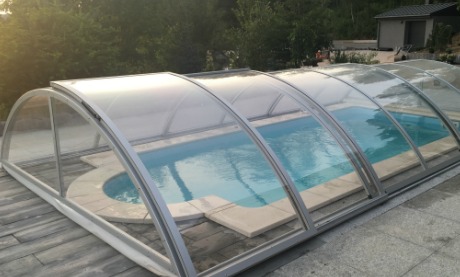
This is a fully assembled retractable swimming pool enclosure.
Polycarbonate swimming pool enclosures are designed to protect the pool from harsh and devastating environmental conditions. These include high speed wind and snow.
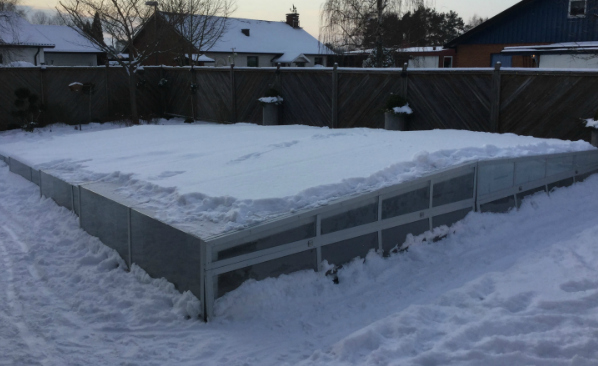
A retractable swimming pool enclosure strong enough to protect the pool from heavy snow loads.
Features of Polycarbonate Swimming Pool Enclosures
Some of the key features of swimming pool enclosures include:
- A 3mm polycarbonate cover
A 3 mm thick polycarbonate solid sheet has an 85% to 91% light transmittance and 250 – 300 times stronger than the ordinary glass. It can withstand high level of impacts such as a 3kg drop from about 2 meters.
Furthermore, the polycarbonate sheet comes with an anti-ultraviolet radiation layer. This protects both swimming pool chemicals from decomposition and users from sunburn.
- A 6063 extruded aluminum structure
The structure is corrosion resistant. Even at the sea level where its rate of corrosion is nearly 0.018mm/year.
The tracks are also made from aluminum material, thus the cover can slide seamlessly. This is in the case of retractable swimming pool enclosures.
Normally, these swimming pool enclosures have lockable doors for safety. Also, they can withstand a wind speed of 230km/hr. and a 900 kg load distributed with 1.5 m radius.
Types of Swimming Pool Enclosures
There are many types of pool enclosures you can use as a cover after heating a swimming pool. Some of the most common designs include:
- High vs. low profile swimming pool enclosures
With a high swimming pool enclosure, you can easily put chairs of walk freely within the swimming pool. This implies that all the heat will be trapped within this enclosure.
On the other hand, for the low profile pool enclosure, distance between the surface of water and the upper section is small. You can comfortably swim when the cover is closed, however, it is nearly impossible to stand on the pool deck.
- Fixed vs. retractable swimming pool enclosure
In a fixed swimming pool enclosure, the entire cover neither opens nor closes. This implies, you’ll have only an indoor experience.
However, for a retractable swimming pool enclosure, you can easily open the entire swimming pool cover. Therefore, you can have both an outdoor and indoor experience at the same time.
- Wall mounted swimming pool enclosure
A wall mounted swimming pool enclosure has one of its ends fixed to the wall. They are suitable for swimming pools that are close to a wall.
Apart from these, we may classify swimming pools depending on their roof designs. That is, you may have flat, sloping, gable or dome roof designs.
When evaluating all these examples, you’ll realize that an enclosure completely covers the swimming pool.
So first, it shields the swimming pool from high speed wind that facilitates evaporation and loss of heat. Remember, during evaporation, both heat and water is lost.
Second, a solid polycarbonate sheet has a high R-value. Therefore, it will maintain the swimming pool temperature.
The good news is that the cost of swimming pool enclosure has reduced significantly. At $2,999 you can get a polycarbonate swimming pool enclosure.
Apart from this, you can prevent heat loss from the swimming pool using pool covers.
Swimming Pool Covers
At the moment, there are over 6 different types of swimming pool covers.
Swimming pool covers are flat materials that completely cover the pool.
Unlike the swimming pool enclosure, the distance between the cover and the water surface is very small.
Therefore, during summer when you cover the pool, these accessories easily radiate heat to the surface of water.
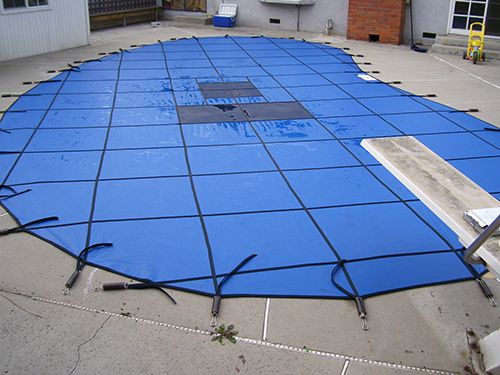
A swimming pool cover protecting pool
In one of my previous blogs, I did cover every critical aspect of the swimming pool covers.
Here is where you can learn about these accessories: Swimming Pool Covers: Ultimate Guide to Choosing the Best Safety Cover for Your Outdoor Pool.
Here are a list of swimming pool covers you’ll learn in that article:
- Solar pool covers
- Thermal swimming pool covers
- Automatic swimming pool covers
- Winter pool covers
- Safety pool covers
- Sliding deck pool covers
These covers will protect the pool from many environmental conditions such as change in humidity, fluctuating temperature and wind.
This implies the covers will prevent heat loss.
Again, from the example you’ve seen above, it is quite clear that swimming pool covers do not give you enough room for swimming.
Actually, you’ll suffocate when the pool is covered.
This makes swimming pool enclosure a suitable choice for this task.
So, I’d recommend that you spend $2,999 to get an enclosure that will prevent heat loss, while giving room for swimming.
Conclusion
As you can see, finding a perfect swimming pool heating system can be quite challenging.
However, including an appropriate accessory to reduce heat loss when the heating system is off can save you a lot of money.
Normally, the initial cost of investment of say swimming pool enclosure and pump or solar heating system can be high.
However, it will eventually pay off.
Always remember, heating a swimming pool is quite expensive, thus, conserving heat will save you from unnecessary additional expenses.
For questions, advice or contributions on swimming pool enclosures and heating systems, don’t hesitate to contact us.
